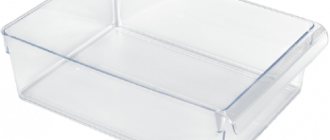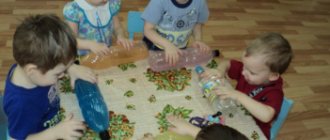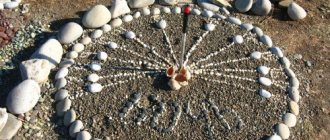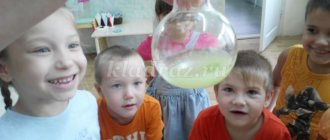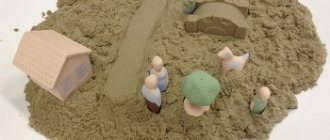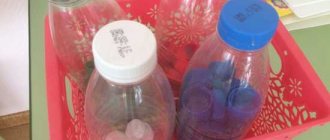Notes on experiments with sand for younger children
Brief summary.
For children with impaired vision, the development of other, intact analyzers is very important. One of the ways for children with disabilities to explore the world is through experimentation.
This material may be useful for teachers of general education preschool educational institutions and for parents of younger preschoolers.
Experimenting with sand (younger age).
Goal:
to introduce children to the properties of sand, to develop the ability to concentrate; systematically and consistently examine objects, the ability to notice individual details of the overall picture; develop children's observation skills, ability to compare, establish basic cause-and-effect relationships and draw simple conclusions. Introduce safety rules when conducting experiments.
Materials for experimentation:
container with sand, water, stencils, molds, cocktail straws, plastic transparent container (jar).
Experiment 1. “Sand House”
Take a handful of sand and release it in a stream so that it falls in one place.
Gradually, a cone forms at the site of the fall, growing in height and occupying an increasingly larger area at the base. This will be our house. If you pour sand for a long time, drifts (sand rivulets), sand movements similar to a current, appear on the surface of the cone, now in one place, then in another. Children conclude: dry sand is free-flowing and can move. Experiment 2. “Footprints on wet sand”
Wet sand cannot be poured out of the palm of your hand, but it can take any desired shape until it dries. Let's find out with the children why figures can be made from wet sand (working with molds) and leaving interesting imprints - traces (working with stencils).
Experiment 3. “Where is the water?”
Invite children to find out the properties of sand by testing it by touch (loose, dry).
Children pour cups with the same amount of water (pour just enough water to completely sink into the sand). Find out what happened in the container with sand, why the water left (seeped through the sand) where there are more puddles after the rain (there are no puddles on the asphalt, in the sandbox). Experiment 4. “Wind”
Invite children to find out why it is inconvenient to play with sand in strong winds. Children examine the prepared “sandbox” (a jar filled with a thin layer of sand). Together with adults, they create a hurricane - they blow into the sand into a tube and find out what is happening and why (since the grains of sand are small, light, do not stick to each other, they cannot hold on to each other or to the ground with a strong stream of air) .
Sand experiment
Experimental activities
In the junior group "Sparrows"
Experiments with sand
The date of the:
09.11.2017
Amount of children:
8 people
Spent:
Educator - Larionova I.N.
Experimental activity in the younger group on the topic:
"Sand. Properties of sand. Making Easter cakes from sand."
Target:
To develop children's cognitive activity in the process of experimentation. Help expand children's knowledge about the properties of dry and wet sand, activate speech and enrich children's vocabulary.
Tasks
: Introduce children to the properties of sand. Learn to handle sand carefully, do not spill it. Renew your interest in working with sand. Develop the ability to put forward hypotheses, compare and draw conclusions. Learn the new game “Grains of Sand” with the children. Develop children's hand motor skills. Enrich your vocabulary. Develop skills of interaction with peers in the process of joint activities. Cultivate feelings of empathy and compassion. To develop cultural and hygienic skills in children (neatness, neatness).
Material
: touch table with sand, set of molds, scoops, watering cans, napkins.
Move
: I show the children the sand: - Look what I have in my hands? (Sand.) - Correct. This is sand. Tell me, do you like to play with sand? (Answers.) Let's play with it a little and get acquainted with its properties. But first, let's agree that during the game: - we don't put sand in our mouth; - don’t rub your eyes with dirty hands; - We don’t cover ourselves with sand. Go to the sandbox and touch the sand with your hands. — What color is the sand? (Brown). I'm pleased, I feel the coolness of the sand. What do you feel (children’s statements).
1 Experience: “Dry, loose sand”
Purpose
: to introduce children to the properties of sand.
Children examine the sand: what color, try it by touch (loose, dry). What is sand made of? What do grains of sand look like? The grains of sand are small, translucent, round, and do not stick to each other. Is it possible to sculpt from sand? Why can't we make anything out of dry sand? Invite children to pour sand from one palm to another.
2 Experience: “Wet Sand” Goal
: Introduce children to the properties of wet sand.
You have molds lying around, let's pour sand in there and make Easter cakes. Work carefully and carefully pour the sand into the molds. The Easter cakes turned out (Children's answers) Why didn't they work out? (Sand is dry). What needs to be done so that you can sculpt from sand? (children's assumptions). Who knows what will happen if you pour water into the sand (children's answers) Let's check. With the help of 1-2 children, we water the sand from a watering can. Touch it and tell me - is it dry or wet? (Wet). That's right, this sand is damp, wet. Look, does wet sand flow as well as dry sand? (Show to children). Of course, wet sand doesn't fall out. You can make Easter cakes from wet sand. Let's try. Take the molds and carefully place wet sand into them. Tap the sand like this with a scoop and compact it. Carefully invert the mold with sand onto the stand. Tap the bottom again with the scoop. Remove the mold. Well done! How beautiful your Easter cakes turned out.
I’ll sum it up with the children (sand can be dry, wet, free-flowing, soft, and can also retain its shape). Sand changes its properties depending on its condition.
Experiments with sand in the second junior group
Albina Shmitko
Experiments with sand in the second junior group
Experiments with sand in the 2nd junior group.
Goal: To develop the cognitive activity of children in the process of experimentation. To help expand children's knowledge about the properties of dry and wet sand .
Tasks:
Training tasks:
Help children better understand the inanimate world around them
Introduce children to the properties of sand .
Learn to handle sand carefully , do not spill it.
Teach children to draw their own conclusions based on examination results.
Developmental tasks:
Create favorable conditions for sensory perception
Develop skills of interaction with peers in the process of joint activities. Enrich your vocabulary.
Educational tasks:
To cultivate the moral qualities of a child during his communication with nature
To develop cultural and hygienic skills in children (neatness, neatness)
.
Experience No. 1 “Getting to know the sand ”
Purpose: to introduce sand , to draw attention to the properties of dry sand (it flows, does not get dirty)
Materials: cups of sand , sheets of white paper, magnifying glasses.
Experiment No. 2 “Does sand fall easily?”
Goal: Learn to pick up sand and hold it in your palms, pour it in a thin stream
Material: trays with sand .
Experience No. 3 “Hide and Seek”
Goal: To teach children to bury (get)
toys in dry
sand , and hide the toys by immersing them in the sand.
Material : sand
Experiment No. 4 “Find objects”
Goal: learn to sift sand through a sieve.
sand center , strainer, small objects (pebbles, beads, etc.)
Experiment No. 5 sand in strong winds ”
Goal: To consolidate knowledge about the properties of sand
Material: sandbox
- a jar with a thin layer
of sand , trays with sand , cocktail tubes.
Experiment No. 6 “Miraculous transformations of sand ”
Mothers: cups with sand and water .
The goal is to teach children to water dry sand from a watering can. Develop the ability to notice changes occurring in sand (Color, condition)
.
Experiment No. 7 “Sculpting from sand ”
Purpose: to introduce children to the properties of wet sand .
Material: trays with wet sand .
Experiment No. 8 “Wet sand takes any desired shape”
Goal: continue to introduce children to the properties of wet sand
Material: tray with wet sand , various molds.
Experiment No. 9 “Whose trace”
Goal: To develop the ability to leave footprints in the sand , then determine what object left the trace.
Material: trays with wet and dry sand .
Experiment No. 10 “Drawing with sand ”
Target. Develop the ability to pour dry sand onto the adhesive pattern, then shake off the excess sand .
Materials: dry sand, sheets of paper with drawn pictures, glue sticks.
Experiments with sand in the younger group
Golovaneva Tatyana
Experiments with sand in the younger group
Goal: Through experiments, teach children to determine the physical properties of sand.
Tasks:
1. Help children better understand the inanimate world around them;
2. Create favorable conditions for sensory perception, improving such vital mental processes as sensations, which are the first steps in understanding the world around us.
3. Through experiments, teach children to determine the physical properties of sand.
4. Teach children to draw independent conclusions based on the examination results.
5. Nurture the moral and spiritual qualities of a child during his communication with nature.
Experiment No. 1 “Where does sand come from”
Target:
find out where sand comes from in nature
Material:
stones, sheets of white paper.
Description:
Take 2 stones and knock them against each other, rub them over a sheet of paper.
How do you think it's pouring in? Consider. How did we get sand? How does sand appear in nature?
Conclusion:
Wind and water destroy stones, resulting in sand.
Experiment No. 2 “What is sand made of”
Target:
find out what sand is made of
Material:
cups with sand, sheets of white paper.
Description:
Place sand on a piece of paper.
What is sand made of? (grains of sand). What do grains of sand look like? Are grains of sand similar to each other?
To get a large pile of sand you need a lot of sand.
Conclusion:
Sand consists of small grains of sand that do not stick to each other.
Experiment No. 3 “Dry bulk sand”
Target:
introduce sand, pay attention to the properties of dry sand (it crumbles)
Material:
cups with sand, sheets of white paper.
Description:
Offer to make a fish out of dry sand. It didn’t work out, it fell apart. Why (sand is falling)
Conclusion:
dry loose sand.
About test No. 4 “Wet sand takes any desired shape”
Target:
Highlight the properties of wet sand.
Material:
tray with wet sand, various molds.
Description:
pour wet sand into the molds, compact them, turn them over. Did you get the figures?
Conclusion:
Wet sand takes any shape.
Experiment No. 5 “Does sand fall easily?”
Target:
Learn to pick up sand and hold it in your palms, pour it in a thin stream
Material:
trays with sand.
Description:
Give the children warm and cold sand, clarify which sand is where. Suggest pouring it between your fingers in small thin streams. Which sand was more pleasant to play with?
Conclusion:
in hot weather it is more pleasant to play with cool sand, in cold weather - with warm sand.
Experiment No. 6 “Sand movement”.
Target:
familiarization with the properties of sand.
Material:
trays with wet and dry sand, straws.
Description:
Take the tubes and gently blow into the tube onto the dry sand.
What's going on (he's moving)
Now blow on the damp sand?
What's happening? The grains of sand are wet and they do not move.
Conclusion:
Dry sand moves, but wet sand does not.
Experiment No. 7 “Where did the water disappear?”
Target:
show that sand easily absorbs water.
Material:
cups with sand and water.
Description:
Pour water into a glass with sand. Touch the sand. What has he become?
Where did the water go?
Conclusion
: Water is quickly absorbed into the sand.
